The two valid species of the North American hadrosaur Edmontosaurus, E. annectens and E. regalis, are known from multiple fossil specimens. Taken together, they make the genus “fully known.” But while a complete skeleton can give us a reasonable idea about an animal’s appearance in life, it is not necessarily a full or accurate one. This was made abundantly clear to us back in 2013 when it was found that E. regalis bore a fleshy comb atop its head. Both Safari Ltd. and Mattel included this comb on their 2020 toys, but yet another very intriguing discovery would come to light that very same year. Which brings us to CollectA’s 2022 Deluxe Edmontosaurus.
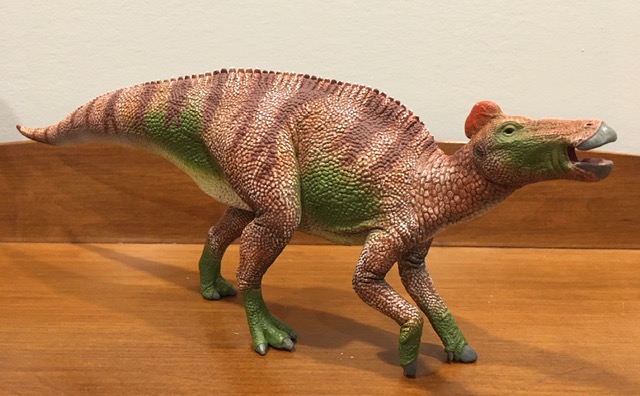
Like most modern hadrosaur toys, this one is sculpted in a quadrupedal walking stance. The right front limb is raised in mid-step while the left hind one is extended back. The tail is swaying to the left and the head is raised and turned slightly to the right with the mouth agape. This individual might be browsing on greens as it strolls casually through the Cretaceous landscape. Or it might be sounding off as part of a courtship or threat display. Or perhaps it’s just been caught off guard by a tyrannosaur bursting out of the brush directly in front of it. In any case, this Edmontosaurus measures just over 34 cm long from bill to tail tip and stands nearly 13 cm tall at the hips. This makes it the largest ornithopod that CollectA has produced to date.
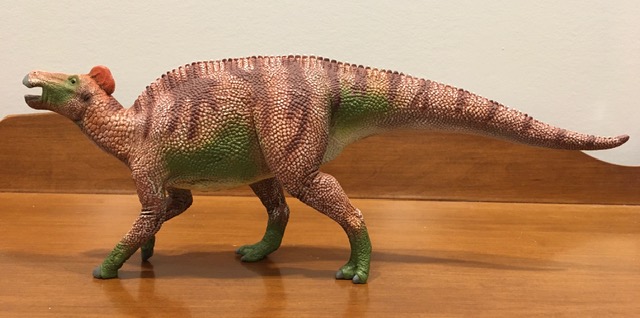
The main colour here is a shade of reddish brown with a very light brown wash applied across much of the surface. Medium brown stripes run down the body all the way to the end of the tail. The underbelly is sandy beige with airbrushed dark brown over the cloaca. The same shade of brown is also applied over the ears. Dark green is used for the hands and feet as well as the large patches on the sides of the skull, the torso, and the base of the tail. The eyes and nostrils are black and the inside of the mouth is pink. And finally, deep red is used for the comb and dark grey for the hind claws, the front hooves, and the keratinous beak. It’s an interesting colour scheme overall, although it would have looked more unified without the green parts.
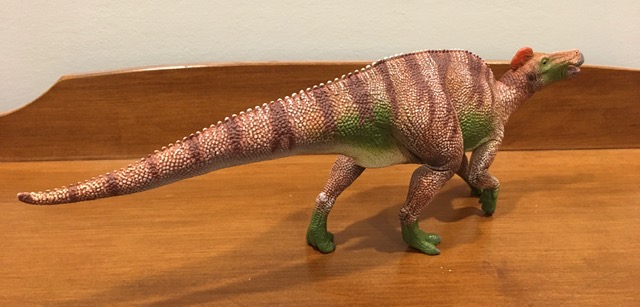
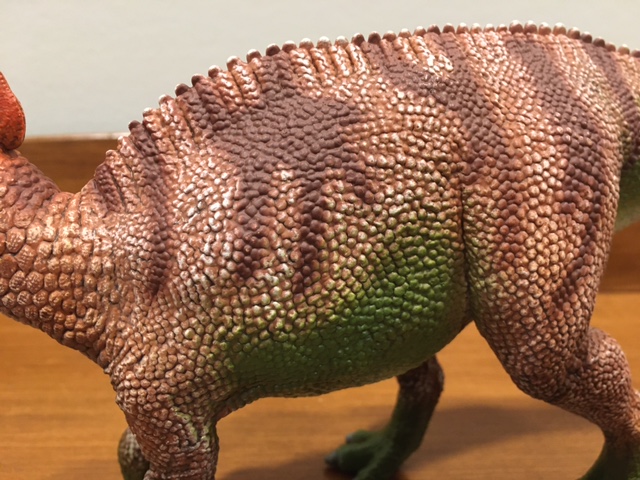
The Edmontosaurus‘ body is completely covered in finely sculpted, rounded scales which range in size from very small ones on the head to medium-sized ones on the limbs, torso, and tail and finally to very large ones on the neck. While the neck scales may appear to be too large at first–which certainly is a common issue with even the top manufacturers of dinosaur toys–they are in fact in keeping with preserved skin impressions of E. regalis. Indeed, the head and neck on this toy look rather similar to master paleoartist Julius Csotonyi’s rendition.
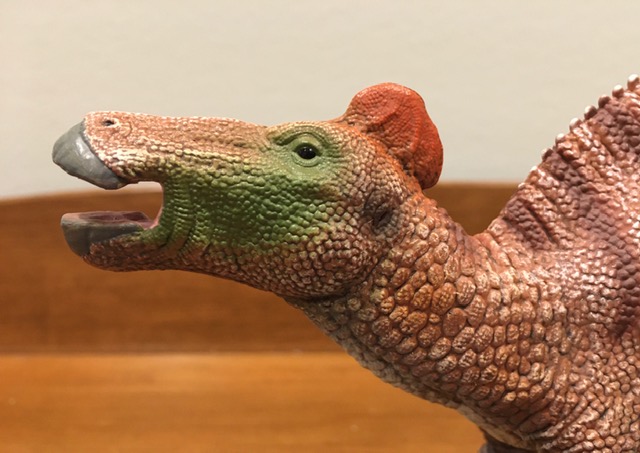
A row of small blunt osteoderms runs down the animal’s spine from the base of the neck to the tip of the tail. The skin over the neural spines is ribbed on both sides, although it does not appear to denote said spines, as there would be too many if that were the case. The beak has a slightly worn feel to it and there is a tongue visible inside the mouth. The muscles in the limbs are well-defined and the thick neck and tail make this animal look beefy and imposing. As I’ve noted in the past, hadrosaurs are frequently used as ‘stock fodder’ for theropods in paleoart and museum displays, undoubtedly due in large part to their lack of horns, spikes, and armour, but in reality, a mature adult Edmontosaurus like this one would have been difficult, even dangerous, for any tyrannosaur to tackle. After all, a female Asian elephant also lacks any kind of armour or pointy bits, but its sheer size and strength means that it doesn’t really need them to defend itself from hungry tigers.
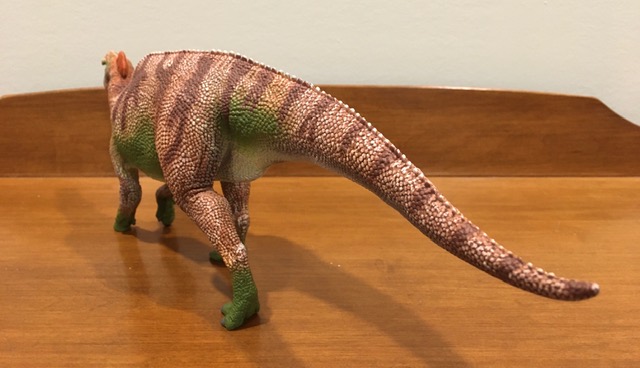
The Edmontosaurus‘ skull features the familiar long snout terminating in a bulging tip with a superficially duck-like beak. The now-famous comb stands tall and proud atop the cranium. Its precise function is unknown, although species recognition and sexual display are two reasonable possibilities. If the latter was the case, then it is also possible that only males possessed them, or at least possessed bigger and flashier ones just like many modern birds. It is also presently unknown whether only E. regalis had a comb, or if the later E. annectens had one as well, but the possibility certainly exists. And furthermore, it is unknown if other crestless hadrosaurs such as Kritosaurus and Shantungosaurus had combs or some other fleshy structures on their heads. We may well never find out. Or perhaps we will. Who knows?

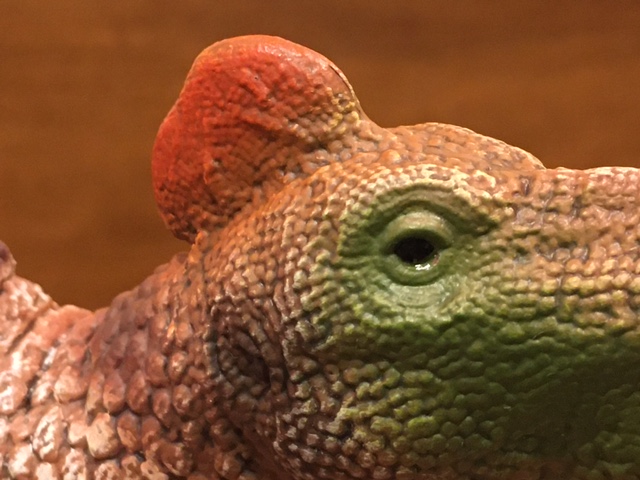
(UPDATED 01/17/22) And that brings us to the most exciting feature of this toy: the “hooves.” Back in the fall of 2019, word leaked out of a stunning discovery involving a “mummified” E. annectens specimen dubbed Dakota. Dakota’s right hand is exceptionally well preserved and shows what appears to be a large, hoof-like nail covering the third phalanx. The second ends in a pointed claw, the fourth is completely concealed within the “mitten,” the fifth is small and clawless, and as for the first one, well, it doesn’t exist at all. As far as I am aware, the Dakota specimen is currently being studied at the North Dakota Heritage Center and no formal description has yet been published. In the mean time, CollectA has strived to accurately capture all of the features listed above on their toy. But in their enthusiasm, they may have gone too far. Soon after I first posted this review, paleontologist Thomas Holtz informed me that the nail over the third phalanx only covers the front surface and not the bottom as a proper hoof would. A more accurate rendition would properly look like this illustration instead. And given that no other preserved Edmontosaurus specimen shares this feature, there is a question if it is even properly identified. Hopefully we will learn more about this strange fossil in the near future.
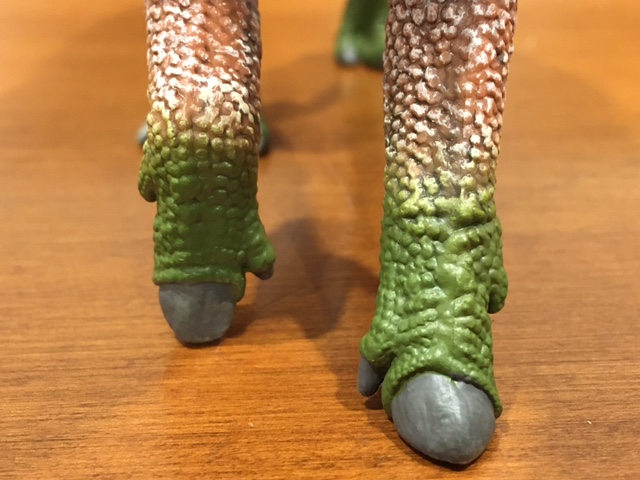
CollectA has not officially stated which species of Edmontosaurus this toy is supposed to be, but based on both the comb and the large neck scales, the logical conclusion is regalis. No direct evidence of large front nails has been found on any known regalis specimen to date, but it may well be that it possessed them just as it’s possible that annectens also possessed a comb. For that matter, it’s possible that other hadrosaurs possessed them as well. Or not. Such is the uncertain and ever-changing nature of paleontology.
“Thoughts aren’t important: what we need is data. Published photos, chemical samples, comparisons to other Edmontosaurus feet.” -Thomas Holtz

Even if they didn’t get the front nails quite right, this Edmontosaurus is awesome nonetheless. It is meticulously sculpted, marvellously massive, and it shows that CollectA is continuing to pay attention to the latest news and developments in paleontology. Truly a more than worthy successor to CollectA’s previous big ornithopod, the 2018 Iguanodon. Huge thanks go out to CollectA for this review sample. It will become available for sale online in the next couple of months.
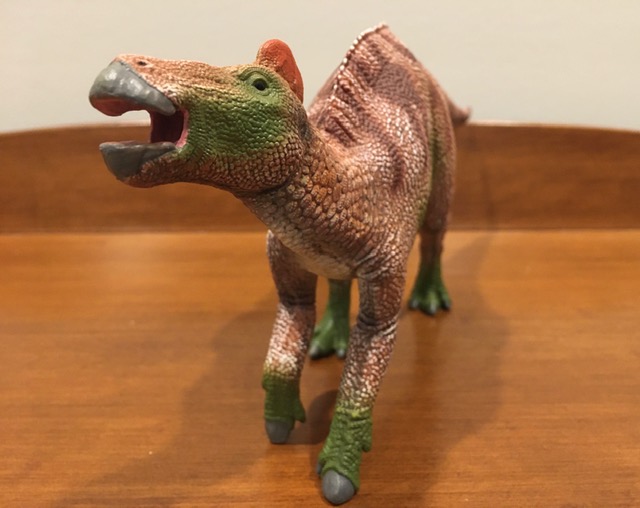
And to close out this entry, please enjoy a series of comparison shots. We begin with the Edmontosaurus getting acquainted with the rest of my CollectA ornithopods.
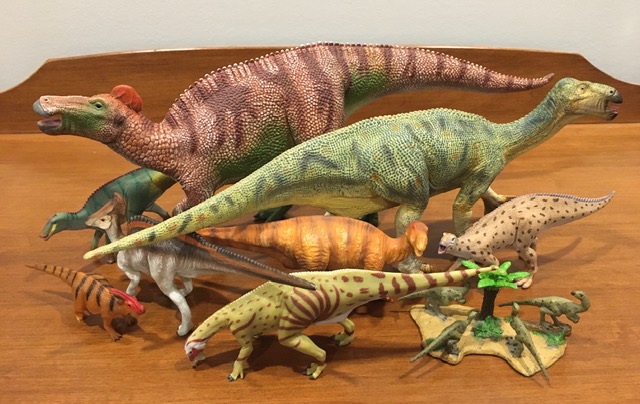
Here it is with Parasaurolophus, Lambeosaurus, and a fellow Edmontosaurus.
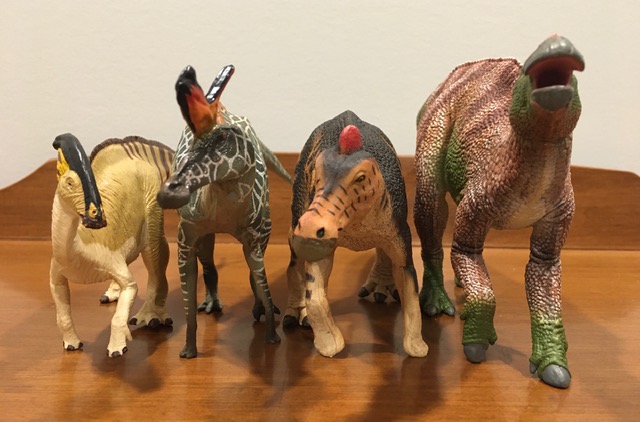
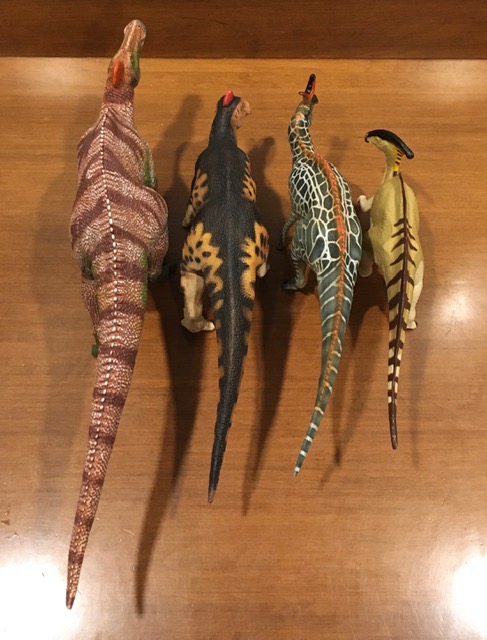
With contemporaries Pachyrhinosaurus, Struthiomimus, and Euoplocephalus.
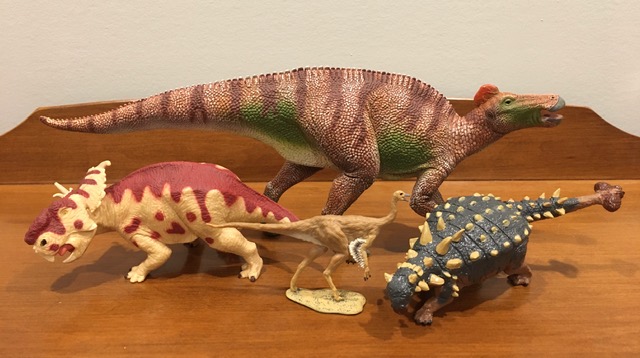
And confronting one of its main enemies, Daspletosaurus.


Disclaimer: links to Ebay and Amazon on the DinoToyBlog are affiliate links, so we make a small commission if you use them. Thanks for supporting us!




Super Review sur edmontosaurus
Beautiful scaling on the neck! I do wish they followed other skin impressions which detail in much more variation in scales across the body, though, because they can definitely do smaller scales like in the pictured Fukuisaurus and Mantellisaurus 😛
Great review as always!
Thanks for covering this model so quickly; this looks like a splendid and well-researched product overall, with only the unsightly green patches being a drawback. I do wonder sometimes how Collecta plans the color schemes for their figures; I feel like they’ve had a lot of figures with ALMOST good patterns that were marred by one attribute or another.
Very nice, and the updated hoof is a nice touch. However, I doubt I’ll replace the Safari figure for this one update, especially since the 2020 Safari figure isn’t too far off from the concept presented here.
Quite a figure! Now that people know to look for it, I hope we get some evidence on whether the ‘hoof’ was widespread among hadrosaurs or saurolophines, or something unique to Edmontosaurus annectens. Nice review!
Thanks! It is saddening to think how there might well have been other hadrosaur specimens with preserved hooves or combs that were completely destroyed during the process of extracting the bones from the rocks.
That thing is a beast! I’ll probably have to get one.
Great review; incredible photography.
Merci!
Wonderful review of this impressive model! It’s bigger that imagined it would be especially next to the other models.
The details looks amazing and very well researched as well.
Thank you!
I like the review that is so thorough scientifically speaking and also magnificently reported regarding the Collecta product. Without a doubt, it makes Collecta’s Edmontosaurus the most impressive and well-finished ornithopod to date from the Collecta brand. The texture looks impressive but the painting honestly, although it could be improved, although it can be solved with a good artistic repainting. It is perhaps, together with its spinosaurus, one of the two best figures of Collecta 2022.
Interesting and informative review. Thanks especially for the contextual group shot from above with the other hadrosaurs – that really shows what a massive model this is.
My pleasure! Comparison shots are always essential for brand new toys.
Thanks for including the reference to the preserved skin impressions. This clears up a negative comment made on the CollectA thread asserting that these were sculpted too large on this figure. Apparently not, then – good. Also the hooves in your presentation were well displayed. Now that I see what needs to be done, I’m going to modify Watson’s otherwise excellent piece to match what CollectA has done with them. Another very useful review, BTW.
Thanks!